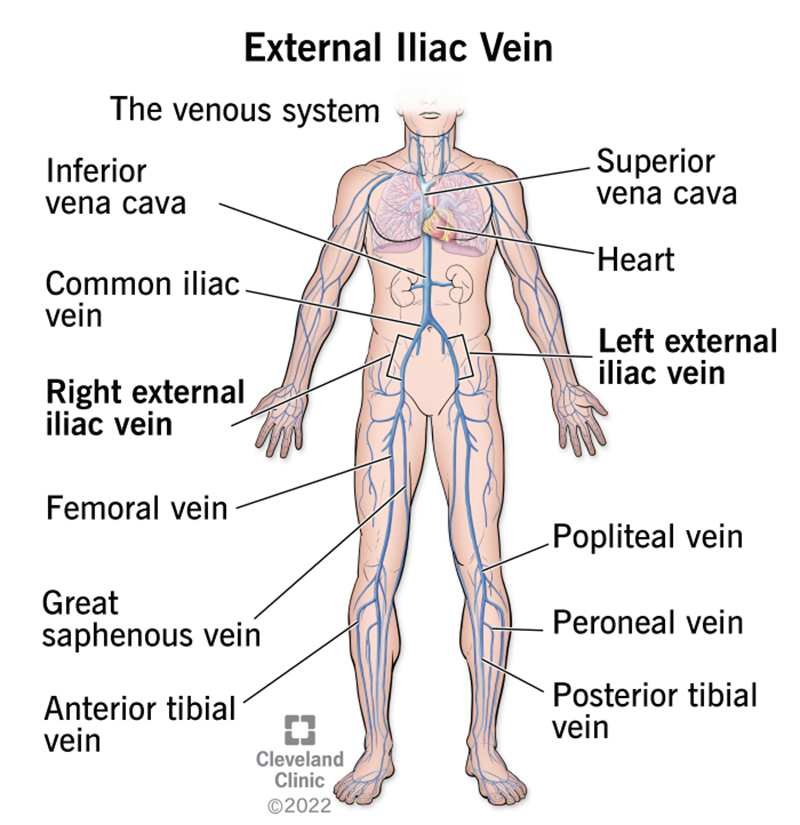The external iliac veins carry oxygen-poor blood from your lower body to your heart. Blood clots can form in your iliac veins, leading to dangerous deep vein thrombosis (DVT) and pulmonary embolisms. The external and internal iliac veins combine to form common iliac veins. These veins join to become the inferior vena cava, your largest vein.
Advertisement
Cleveland Clinic is a non-profit academic medical center. Advertising on our site helps support our mission. We do not endorse non-Cleveland Clinic products or services. Policy

The external iliac veins are blood vessels in your pelvis. Your pelvis is the part of your skeletal system between your lower torso (trunk) and legs. It sits just above where your legs and hips connect.
Advertisement
Cleveland Clinic is a non-profit academic medical center. Advertising on our site helps support our mission. We do not endorse non-Cleveland Clinic products or services. Policy
Your external iliac veins send blood that no longer has oxygen from your lower body back to your heart to get oxygen. These veins are a continuation of the femoral veins, major blood vessels in your thighs. They help carry deoxygenated blood from your legs to your heart.
The internal iliac veins function alongside the external iliac veins. They carry deoxygenated blood from organs in your pelvic area back to your heart. Your internal iliac veins also drain blood from your:
As part of your body’s circulatory system, the external iliac veins carry blood that’s low in oxygen back to your heart from the:
Your circulatory system is made up of arteries, veins and other blood vessels. Most arteries carry blood that has oxygen and nutrients to organs and tissues throughout the body. Oxygenated blood or red blood is rich in oxygen.
After your body uses the oxygen in blood, your veins carry the deoxygenated blood back to your heart. Your heart pumps the blood to the pulmonary arteries in your lungs to get oxygen. You may hear the terms blue blood or oxygen-poor blood to refer to blood that’s low in oxygen.
Advertisement
Each side of your body has an external and internal iliac vein. These veins are peripheral blood vessels, which means they are far from your heart. Iliac arteries run alongside the iliac veins.
Around your sacroiliac (SI) joint, the pairs of external and internal iliac veins join to form the right and left common iliac veins. The SI joint is where the sacrum (the bottom section of your spine) meets your pelvis.
Higher up, near the fifth vertebra in your spine, the right common iliac vein and left common iliac vein come together to create the inferior vena cava. The inferior vena cava is your body’s largest vein. It carries oxygen-poor blood from your lower body to your heart.
The external iliac veins are in your pelvis. They’re an upward continuation of the femoral veins in your thighs. External iliac veins:
Several smaller veins send deoxygenated blood to the external iliac veins:
The following conditions can affect external iliac veins:
Advertisement
These actions can keep your external iliac veins healthy while lowering your risk of blood clots:
You should call your healthcare provider if you experience:
The external iliac veins play a critical role in sending oxygen-poor blood from your lower extremities to your heart. These veins connect to the femoral and internal iliac veins to form the inferior vena cava, the body’s largest vein. Blood clots can form in veins deep in your legs, increasing your risk for potentially life-threatening problems like deep vein thrombosis and pulmonary embolisms. Getting quick care for symptoms of vein problems can safeguard your health.
Advertisement
Cleveland Clinic’s primary care providers offer lifelong medical care. From sinus infections and high blood pressure to preventive screening, we’re here for you.

Last reviewed on 03/15/2022.
Learn more about the Health Library and our editorial process.